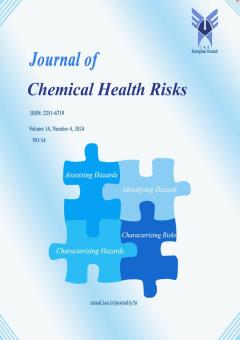Sulfites in the Filipino Diet: A Dietary Exposure Assessment Using the Harmonized Philippine Food Consumption Database
الموضوعات :
Elyss G. Billedo
1
![]() ,
Rose Elaine Guilaran
2
,
Avegail D. Apor
3
,
Rose Elaine Guilaran
2
,
Avegail D. Apor
3
![]() ,
Miszhah Faye M. Lipana
4
,
Miszhah Faye M. Lipana
4
![]() ,
Paola Bianca M. Buiser
5
,
Paola Bianca M. Buiser
5
![]()
1 - Department of Science and Technology, Food and Nutrition Research Institute (DOST-FNRI), Bicutan, Taguig City, Philippines
2 - Department of Science and Technology, Food and Nutrition Research Institute (DOST-FNRI), Bicutan, Taguig City, Philippines
3 - Department of Science and Technology, Food and Nutrition Research Institute (DOST-FNRI), Bicutan, Taguig City, Philippines
4 - Department of Science and Technology, Food and Nutrition Research Institute (DOST-FNRI), Bicutan, Taguig City, Philippines
5 - Department of Science and Technology, Food and Nutrition Research Institute (DOST-FNRI), Bicutan, Taguig City, Philippines
الکلمات المفتاحية: Risk assessment, Food additive, Food chemical hazard, Sulfite exposure,
ملخص المقالة :
This study aimed to update the current consumption database for dietary exposure assessment based on the 2019 browser version of FoodEx2 – the internationally recommended harmonization tool for food code assignment. The updated food consumption database was utilized to estimate the dietary exposure of Filipinos to sulfites, a widely used food additive. A total of 1,541 food items were re-coded using the new FoodEx2 catalog browser. The dietary exposure assessment indicated that Filipinos’ sulfite exposure varies from 27% to 109% of the Allowable Daily Intake (0.7 mg kg-1) for mean and high-level per capita consumption, respectively. Water-based beverages were the main contributor to sulfite exposure across all ages and gender groups. In general, infants and children were highly exposed to sulfites compared with the adults due to their relatively low average body weight. An internationally harmonized national food consumption database in the Philippines was therefore developed, which can provide detailed food information that can assist in facilitating the national, regional, and international agricultural and food programs of food safety.
1. European Food Safety Authority (EFSA). 2015. The Food Classification and Description System FoodEx 2 (Revision 2). EFSA Supporting Publications. 12(5), 804E. https://doi.org/https://doi.org/10.2903/sp.efsa.2015.EN-804.
2. European Food Safety Authority (EFSA). 2011. Evaluation of the FoodEx, the Food Classification System Applied to the Development of the EFSA Comprehensive European Food Consumption Database. EFSA Journal. 9(3), 1970. https://doi.org/https:// doi.org/10.2903/j.efsa.2011.1970.
3. Nikolic M., Ioannidou S., 2020. FoodEx2 Maintenance 2019. EFSA Supporting Publications. 17(3), 1810E. https://doi.org/https: //doi.org/10.2903/ sp.efsa.2020.EN-1810.
4. Ioannidou S., 2019. EFSA FoodEx2 Interpreting and Checking Tool User Guide. EFSA Supporting Publications. 16(11), 1727E. https://doi.org /https://doi.org/10.2903/sp.efsa.2019.EN-1727.
5. World Health Organization (WHO). 2019. Call for data on food consumption summary statistics for chronic dietary exposure assessment. https://www.who.int/news-room/articles-detail/call-for-data-on-food-consumption-summary-statistics-for-chronic-dieatry-exposure-assessment (Accessed December 12, 2022).
6. European Food Safety Authority (EFSA). 2022. https://www.efsa.europa.eu/es/data-report/food-consumption-data (Accessed December 28, 2023).
7. Carocho M., Barreiro M.F., Morales, P., Ferreira, I., 2014. Adding Molecules to Food, Pros and Cons: A Review on Synthetic and Natural Food Additives. Comprehensive Reviews in Food Science and Food Safety.13(4), 377-399.
8. Vally H., Misso N.L., 2012. Adverse reactions to the sulphite additives. Gastroenterol Hepatol Bed Bench. 5(1),16-23.
9. Food and Agriculture Organization and World Health Organization (FAO/WHO). CIFOCOss Template. cifocoss-template.xlsx (live.com).
10. Food and Agriculture Organization and World Health Organization (FAO/WHO). 2018. General Standard for Food Aditives: Codex Standard 192-1995; http://www.fao.org/gsfaonline/index.html;jsessionid=1BB09F492F25A5C7BB44235D7B761D1F.
11. Food and Agriculture Organization and World Health Organization (FAO/WHO). 2014. Guidelines for the Simple Evaluation of Dietary Exposure to Food Additives CAC/GL 3-1989. 1–12.
12. World Health Organization (WHO). 1985. Guidelines for the Study of Dietary Intakes of Chemical Contaminants.
13. Department of Science and Technology – Food and Nutrition Research Institute (DOST-FNRI). 2015. Philippine Dietary Reference Intake. http://www.fnri.dost.gov.ph/images/sources/PDRI- s.pdf
14. Ioannidou, S., Nikolic, M., Gibin, D. 2019. FoodEx2 Maintenance 2016‐2018. EFSA Supporting Publications. 16(2). https://doi.org/10.2903/sp.efsa.2019.EN-1584.
15. World Health Organization (WHO). 1997. Guidelines for Predicting Dietary Intake of Pesticide Residues.
16. Cressey, P., Jones, S., 2009. Levels of Preservatives (Sulfite, Sorbate and Benzoate) in New Zealand Foods and Estimated Dietary Exposure. Food Addit Contam Part A Chem Anal Control Expo Risk Assess. 26(5), 604–613. https://doi.org/10.1080/02652030802669188.
17. Food Standards Australia New Zealand (FSANZ). 2005. The 21st Australian Total Diet Study: A Total Diet Study of Sulphites, Benzoates and Sorbates; https://www.foodstandards.gov.au/publications/documents/21st%20ATD%20Study%20report-Aug051.pdf (Accessed December 12, 2022).
18. Urtiaga, C., Amiano, P., Azpiri, M., Alonso, A., Dorronsoro, M., 2013. Estimate of Dietary Exposure to Sulphites in Child and Adult Populations in the Basque Country. Food Additives & Contaminants: Part A. 30 (12), 2035–2042. https://doi.org/ 10.1080/19440049. 2013.840930.
19. Joint FAO/WHO Expert Committee on Food Additives (FAO/WHO). 2011. Safety Evaluation of Certain Food Additives and Contaminants.


